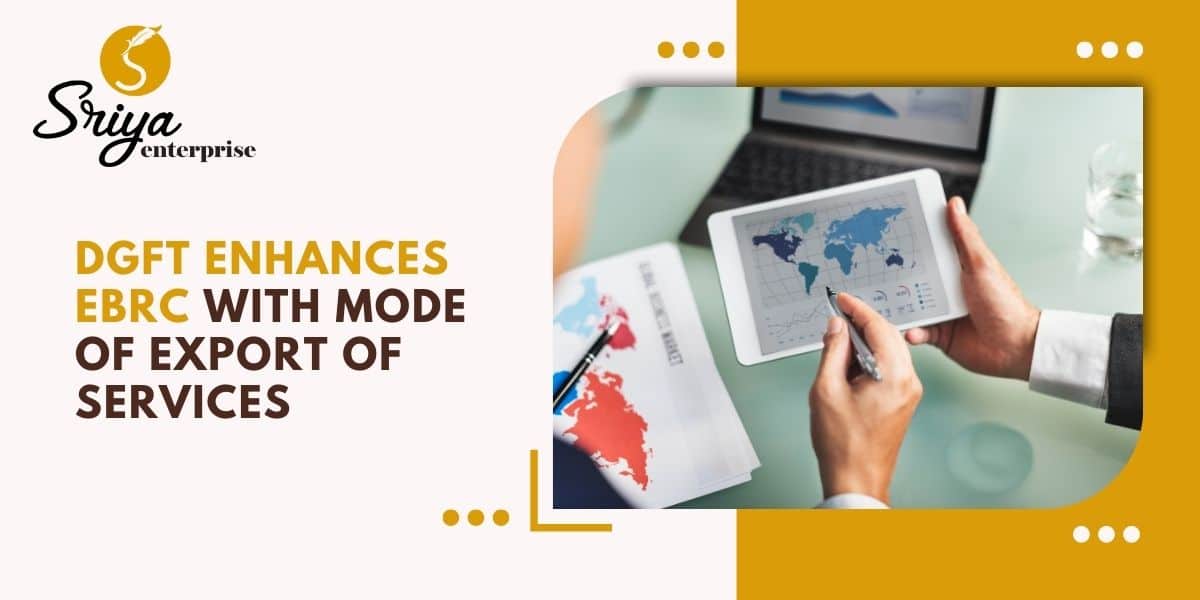The Reserve Bank of India (RBI) has recently tightened its regulations concerning Overseas Direct Investments…

DGFT Introduces ‘Mode of Export of Services’ Field In eBRC Format For Services Exports W.E.F May 01, 2025
The Directorate General of Foreign Trade (DGFT) has introduced the ‘Mode of Export of Services’ field in Electronic Bank Realisation Certificates (eBRCs) Format for Services Exports with effect from May 01, 2025.
As per the Foreign Trade (Development & Regulation) [FTDR] Act, 1992, Chapter 1, Para 2, Sub-para (j) which states that,-“services” means service of any description which is made available to potential users and includes all the tradable services specified under the General Agreement on Trade in Services entered into amongst India and other countries who are party to the said Agreement: Provided that, this definition shall not apply to the domain of taxation;
The service export classification nomenclature is also defined in the General Agreement on Trade in Services (GATS) of the World Trade Organization (WTO).
The new field – ‘Mode of Export of Services’ – corresponds to the four modes of services trade which have been mentioned under the General Agreement on Trade in Services (GATS).
The 4 mode of ‘Mode of Export of Services’ includes Cross- Border Supply, Consumption Abroad, Commercial Presence, and Presence of Natural Persons.
Mode 1: Cross- Border Supply
The term cross-border supply refers to Services supplied (from India) remotely across borders without movement of individuals. For example IT services, remote consulting, telemedicine.
Mode 2: Consumption Abroad
The Consumption Abroad means Consumer travels to the service provider’s country (i.e. to India). For example Tourism, medical treatment in India, foreign students.
Mode 3: Commercial Presence
The term Commercial Presence means Service supplier (from India) establishes a commercial entity abroad. For example Indian bank branches overseas, IT company subsidiaries.
Mode 4: Presence of Natural Persons
The term Presence of Natural Persons means an individual (from India) travels abroad temporarily to provide services. For example Engineers, doctors, IT professionals on assignment.
If you’re a service exporter in India—be it consulting, marketing, or any other professional service—there’s one small digital document that holds big importance: the e-BRC, or Electronic Bank Realization Certificate.
But what exactly is it, and why is it so crucial for service exporters? Let’s break it down.

What is an e-BRC?
The e-BRC is an electronic certificate issued by banks in India, confirming that a service exporter has received payment in foreign currency. Once the bank uploads this certificate to the DGFT (Directorate General of Foreign Trade) portal, it becomes official proof of export earnings.
An e-BRC (Electronic Bank Realization Certificate) is essential for service exporters in India primarily for the following reasons:
1. Proof of Foreign Exchange Realization
- The e-BRC is a digital proof that foreign currency has been received against an export of services.
2. Claiming Export Incentives
3. GST Refunds
- If a service exporter is supplying services under LUT (Letter of Undertaking) without payment of IGST, they need to show foreign exchange realization to get GST refunds.
- The e-BRC acts as proof for this.
4. Regulatory Compliance
- e-BRC helps DGFT, RBI, and other agencies monitor export transactions, foreign exchange inflows, and curb fraudulent claims.
e-BRC = Verified digital evidence of foreign exchange earned from service exports — necessary for incentives, compliance, and credibility. The e-BRC might seem like just another piece of paperwork, but it’s actually a cornerstone of your export operations. For service exporters in India, it’s not optional—it’s essential.




